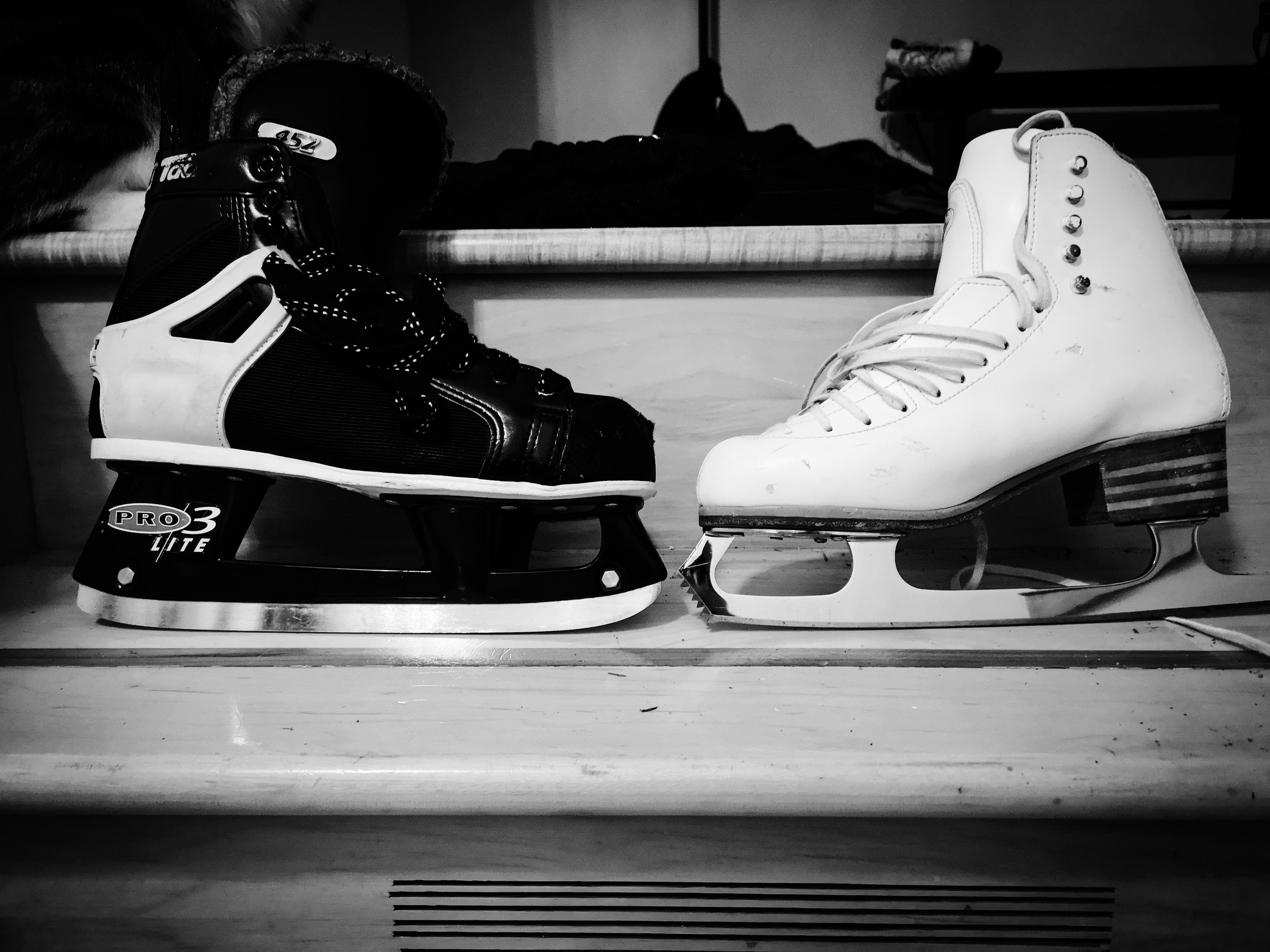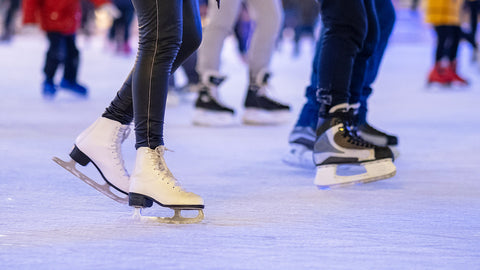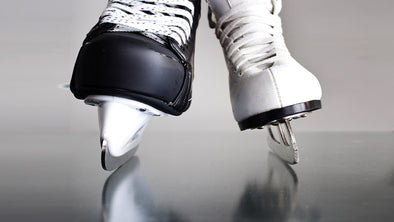Ice hockey skates are designed for speed and agility, with a flat blade and ankle support, while figure skates have a toe pick, a curved blade, and more ankle flexibility. Whether you are gliding on ice or performing complex jumps and spins, the type of skate you choose makes a significant difference in your performance.
Figure skates are crafted for graceful movements and intricate footwork, whereas ice hockey skates are focused on quick turns and rapid movements. Understanding the variations between these two types of skates will enable you to choose the appropriate one for your specific needs and goals on the ice.
Now, let’s dive into the details of each and explore their unique features.
Table of Contents
- 1 History Of Ice Hockey Skates
- 2 History Of Figure Skates
- 3 Design Differences
- 4 Key Components Of Ice Hockey Skates
- 5 Key Components Of Figure Skates
- 6 Performance Differences
- 7 Safety Considerations
- 8 Maintenance And Care
- 9 Cost Comparison
- 10 Choosing The Right Skates
- 11 Popular Brands And Models
- 12 Frequently Asked Questions For What Is The Difference Between Ice Hockey Skates And Figure Skates
- 12.1 What Are The Main Differences Between Ice Hockey Skates And Figure Skates?
- 12.2 Which Type Of Skates Are Better For Beginners, Ice Hockey Skates, Or Figure Skates?
- 12.3 How Do The Blade Designs Of Ice Hockey Skates And Figure Skates Differ?
- 12.4 What Are The Key Factors To Consider When Choosing Between Ice Hockey Skates And Figure Skates?
- 12.5 Can Ice Hockey Skates Be Used For Figure Skating, Or Vice Versa?
- 12.6 Which Skates Are More Suitable For Precision And Intricate Footwork On The Ice?
- 12.7 What Impact Do The Differences Between Ice Hockey Skates And Figure Skates Have On Performance?
- 13 Conclusion
History Of Ice Hockey Skates
The history of ice hockey skates dates back centuries, with early variations being crafted from bone, wood, and even iron. Over time, these skates evolved to meet the specific needs of different ice sports, leading to the distinctive differences between ice hockey skates and figure skates.
Evolution
Ice hockey skates have undergone a significant evolution to address the demanding nature of the sport, characterized by its high-speed, quick turns, and physicality.
Key Innovations
One of the key innovations in ice hockey skates was the introduction of a shorter blade and a more pronounced heel, providing better maneuverability and agility on the ice.
History Of Figure Skates
Figure skating is a beautiful and elegant sport that has captivated audiences for centuries. But have you ever wondered about the history of those graceful figure skates that glide across the ice with such precision and grace? In this section, we will delve into the fascinating development and design changes that figure skates have undergone over time.
Development
The roots of figure skating can be traced back to the 19th century when it emerged as a popular pastime for the upper class. During this time, skaters would attach blades to their shoes, creating makeshift skates. These early skates were nothing like the advanced designs we see today, but they paved the way for the development of figure skates as we know them now.
As the sport of figure skating gained popularity, a need arose for specialized skates that would allow skaters to perform complex moves and jumps on the ice. This led to the evolution of figure skates into a distinct type of ice skate designed specifically for figure skating.
Design Changes Over Time
Over the years, figure skate designers have made numerous modifications and refinements to enhance performance and safety. Let’s take a closer look at the notable design changes that have taken place over time:
- Blade Design: One of the most crucial components of figure skates is the blade. Early figure skates had straight blades, but as skaters began to experiment with more intricate moves and jumps, the need for curved blades became apparent. Curved blades provided skaters with better stability and control, allowing them to execute impressive maneuvers with greater ease.
- Boot Construction: The construction of figure skate boots also experienced significant advancements. Early boots were made of leather, which often became stiff and uncomfortable over time. However, modern figure skate boots are constructed with a combination of leather and synthetic materials, providing a balance of flexibility, support, and durability.
- Toe Picks: Another notable design change in figure skates is the addition of toe picks. Toe picks, small teeth-like protrusions located at the front of the blade, allow skaters to execute jumps and spins with precision. The introduction of toe picks revolutionized figure skating, enabling skaters to perform more complex maneuvers and showcasing their skills to the fullest.
These advancements in blade design, boot construction, and the addition of toe picks have transformed figure skates into highly specialized equipment that maximizes skaters’ performance and enables them to push the boundaries of their sport.
Design Differences
Ice hockey skates and figure skates have notable design differences. Ice hockey skates have a shorter blade and a sturdier build for quick turns and abrupt stops. On the other hand, figure skates have a longer blade and a more flexible structure to allow for graceful and precise movements on the ice.
Whether you’re playing hockey or figure skating, choosing the right skates can greatly enhance your performance.
Boot Structure
Ice hockey skates have a more rigid and robust boot structure for better ankle support.
Figure skates, on the other hand, feature a more flexible and lighter boot to allow for greater mobility and ease of movement.
Blade Design
Ice hockey skates have shorter, curved blades that facilitate quick turns and agility on the ice.
Figure skates come with longer, straighter blades that enable stability and precision for jumps and spins.
Weight Distribution
Ice hockey skates distribute weight more evenly towards the front for enhanced speed and acceleration.
Figure skates place more weight towards the back for improved balance and control during intricate moves.

Credit: connectingwithscience.org
Key Components Of Ice Hockey Skates
Ice hockey skates and figure skates are designed differently to meet the specific needs of each sport. Understanding the key components of ice hockey skates is essential for hockey players to optimize their performance on the ice. Let’s delve into the crucial elements of ice hockey skates.
Boot
The boot of ice hockey skates is designed to provide ankle support and stability. It is typically made of synthetic materials or leather, featuring a stiff construction to support the player’s foot during quick movements and turns.
Blade
The blade of hockey skates is shorter and more curved compared to figure skates, enabling quick turns and maneuvers on the ice. The blade is made of high-grade stainless steel, ensuring durability and precision during skating.
Holder And Runner
The holder and runner are crucial components that connect the blade to the boot. The holder provides a secure attachment for the blade, while the runner, the part in direct contact with the ice, is designed to deliver optimal gliding and maneuverability.
Lacing System
The lacing system of ice hockey skates is designed to provide a snug and secure fit, allowing players to have full control over their movements on the ice. The laces are strategically positioned to distribute pressure evenly across the foot, enhancing comfort and stability.
Key Components Of Figure Skates
Figure skates are distinct from ice hockey skates due to their toe picks, designed for executing jumps and spins. They also feature a higher, more rigid boot for ankle support and better control. The blades are longer and flatter, providing stability for intricate footwork and spins.
When it comes to figure skating, one of the most important factors that can greatly impact performance is the choice of skates. Figure skates are specifically designed to enhance the skater’s ability to execute intricate moves, spins, and jumps. Understanding the key components of figure skates is crucial in order to make an informed decision when purchasing a pair. These components include the boot, blade, toe pick, and support.
Boot
The boot is the primary component of figure skates and serves as the foundation for the skater’s foot. It provides the necessary support and protection while allowing for flexibility and movement. Figure skate boots are typically made of leather, which molds to the shape of the foot over time, ensuring a comfortable fit. The boot should fit snugly around the foot and ankle to provide stability and prevent injury. It is essential to choose a boot that provides the right balance of support and flexibility based on the skater’s level of expertise and personal preferences.
Blade
The blade is a critical component of figure skates that directly impacts the skater’s performance on the ice. It is attached to the bottom of the boot and provides stability and maneuverability. The blade is typically made of stainless steel and consists of a thin metal strip with edges on both sides. These edges are sharpened to create a gliding surface on the ice. The length and shape of the blade vary depending on the skater’s style and skill level. A longer blade offers more stability, while a shorter blade allows for easier maneuverability and quick turns.
Toe Pick
The toe pick is a small, jagged protrusion located on the front of the blade. It plays a crucial role in executing jumps and spins in figure skating. The toe pick helps the skater gain traction on the ice and provides a platform for launching into the air for jumps. Skaters use the toe pick as an aid to push off and generate upward momentum for their jumps. The size and shape of the toe pick can vary, with more advanced skaters often opting for larger and more aggressive toe picks to facilitate intricate moves.
Support
Support is another important component of figure skates, particularly for beginners and less experienced skaters. The level of support provided by the boot and blade combination determines the skater’s stability and control on the ice. Figure skates offer varying degrees of support based on the skater’s level of expertise and the demands of their routine. Beginners typically require more support to develop their balance and skills, while advanced skaters may prefer a more flexible boot for enhanced agility and movement.

Credit: www.polyglidesyntheticice.com
Performance Differences
Speed And Maneuverability
Ice hockey skates are designed for speed with a shorter blade, while figure skates prioritize stability.
Turning And Stopping
Hockey skates allow quick turns and stops with their curved blades, whereas figure skates provide better control for precise movements.
Jumping And Spins
Ice hockey skates are not ideal for jumps and spins due to their less specialized design compared to figure skates.
Safety Considerations
Ice hockey skates and figure skates differ in the blade design and ankle support, emphasizing agility and stability, respectively. Safety considerations revolve around the type of skating activity and the skater’s skill level to prevent injuries and ensure proper performance.
Understanding these differences is crucial in selecting the right skates for a safe and enjoyable skating experience.
Safety Considerations Ankle Support Ice hockey skates provide better ankle support compared to figure skates. Injury Prevention Proper ankle support in ice hockey skates reduces the risk of ankle injuries. Enhanced stability from figure skates can help prevent falls leading to injuries. Ice hockey skates offer additional padding for protection against impact.Maintenance And Care
Maintenance and care are essential for prolonging the lifespan and performance of ice hockey skates and figure skates. Proper maintenance ensures your skates are always in top shape and ready for the ice. When it comes to maintaining and caring for ice hockey skates and figure skates, there are a few key differences. Let’s take a look at each aspect in detail.
Sharpening
Sharpening is an important part of skate maintenance for both ice hockey skates and figure skates. However, the sharpening process differs slightly between the two types of skates. Ice hockey skates generally require a slightly deeper hollow in the blade to provide better traction on the ice, allowing players to make quick turns and stops. Figure skates, on the other hand, typically have a shallower hollow to provide better stability during spins and jumps.
Tip: To ensure optimal performance, it’s recommended to have your ice hockey skates sharpened every 10-15 hours of ice time and figure skates sharpened every 20-25 hours.
Cleaning
Cleaning your skates regularly is crucial for maintaining their performance and preventing the build-up of bacteria and odor. When it comes to cleaning, ice hockey skates and figure skates require different approaches.
- Ice hockey skates: Start by removing excess debris and wiping down the blade with a cloth to remove moisture. Then, you can apply a thin layer of blade oil to protect against rust.
- Figure skates: Use a soft cloth or sponge to remove debris and wipe down the blade. Avoid using water or chemicals that may damage the blade’s finish.
Storage
Proper storage is essential to maintain the condition of your skates during the off-season or when they’re not in use. Here’s how you can store your ice hockey skates and figure skates:
| Ice hockey skates | Figure skates |
|---|---|
| Remove the skate guards and allow them to air dry | Use blade covers to protect the blades |
| Store them in a cool and dry place | Keep them in a skate bag with proper ventilation |
| Consider using skate soakers or towel wraps for added protection | Avoid storing them in extreme temperatures |
By following these maintenance and care tips, you can ensure that your ice hockey skates and figure skates stay in excellent condition, providing you with optimal performance every time you hit the ice!
Cost Comparison
Ice hockey skates and figure skates differ in several ways, including blade design, boot structure, and comfort level. Ice hockey skates have a curved blade for agility and quick turns, while figure skates have a longer, straighter blade for stability and precise movements.
Additionally, hockey skates offer more ankle support, while figure skates prioritize flexibility for complex jumps and spins. Choose the right skates based on your skill level and preferred skating style.
Cost Comparison When it comes to purchasing ice hockey skates or figure skates, the cost is a significant factor to consider. Both types of skates vary in their initial investment and long-term expenses, including maintenance and durability. Initial Investment Ice hockey skates and figure skates differ in their initial investment. Ice hockey skates are typically designed with more technological features to support the intense movements and gameplay of hockey, resulting in a higher upfront cost. On the other hand, figure skates, while still of high quality, often have a more streamlined design, making them slightly more affordable initially. Long-Term Expenses Ice hockey skates generally incur higher long-term expenses due to the rugged nature of the sport. The constant impact and aggressive movements on the ice can lead to more frequent wear and tear, necessitating repairs or replacements more often. In contrast, figure skates, used primarily for elegant and precise movements, usually require less maintenance and have a longer lifespan, resulting in lower long-term expenses. In conclusion, while the initial investment for ice hockey skates is higher, the long-term expenses tend to be more significant than those of figure skates. When deciding between the two, it’s vital to consider not only the upfront cost but also the overall expenses incurred over time.Choosing The Right Skates
When it comes to ice skating, choosing the right skates is crucial for performance and safety. One of the key decisions is selecting between ice hockey skates and figure skates. Both types have distinctive features tailored to their specific purposes. To make an informed choice, there are several important considerations to keep in mind.
Considerations
Before deciding on the type of ice skates to purchase, it’s important to consider the unique features of both ice hockey skates and figure skates. Each type is designed for specific activities and offers different benefits based on the purpose of use.
Fit And Comfort
Fit and comfort are crucial aspects when choosing between ice hockey skates and figure skates. Both types of skates should provide a snug and comfortable fit to ensure optimal performance and to prevent injuries. Assessing the fit is essential to ensure the skates provide the necessary support and control.
Purpose Of Use
The purpose of use plays a significant role in determining whether ice hockey skates or figure skates are the right choice. Consider the intended activities and the specific requirements of each type of skate. Understanding the purpose for which the skates will be used is essential in making an informed decision.
Popular Brands And Models
When it comes to ice hockey skates and figure skates, there are several popular brands and models that stand out for their quality and performance. Whether you are a professional athlete or a recreational skater, choosing the right brand and model is crucial for your skating experience. Let’s take a closer look at some popular brands and models of ice hockey skates and figure skates:
Ice Hockey Skates
Ice hockey skates are specifically designed for fast and aggressive play on the ice. They are built to withstand the physical demands of the game and provide excellent support and stability. Here are some popular brands and models of ice hockey skates:
- Bauer Vapor 2X Pro: Known for its lightweight design and exceptional fit, the Bauer Vapor 2X Pro is a top choice among professional ice hockey players. It offers maximum agility and speed on the ice.
- CCM Super Tacks AS3 Pro: With advanced technology and a customizable fit, the CCM Super Tacks AS3 Pro delivers unparalleled power and responsiveness. It is engineered to enhance performance and optimize energy transfer.
- Reebok Ribcor 80K: The Reebok Ribcor 80K is renowned for its flexibility and ease of movement. It features a unique ribbed construction that allows for efficient energy transfer and quick acceleration.
Figure Skates
Figure skates are designed for graceful performances, spins, and jumps on the ice. They prioritize comfort and precision to facilitate intricate footwork. Here are some popular brands and models of figure skates:
- Riedell 229 Edge: The Riedell 229 Edge is a favorite among figure skaters for its impeccable craftsmanship and excellent ankle support. It offers a combination of durability and elegance, making it ideal for advanced skaters.
- Jackson Ultima Freestyle Fusion: Known for its outstanding performance and versatility, the Jackson Ultima Freestyle Fusion is suitable for skaters of all levels. It features a reinforced sole and heel for enhanced stability and control.
- Edea Chorus: The Edea Chorus figure skates are highly regarded for their lightweight design and superior comfort. They provide exceptional flexibility and superb shock absorption, allowing skaters to perform with grace and confidence.
Remember, when choosing ice hockey skates or figure skates, it’s important to consider your skill level, playing style, and personal preferences. Each brand and model offers unique features that can enhance your performance on the ice. So, go ahead and explore these popular options to find the perfect fit for your skating needs.

Credit: www.polyglidesyntheticice.com
Frequently Asked Questions For What Is The Difference Between Ice Hockey Skates And Figure Skates
What Are The Main Differences Between Ice Hockey Skates And Figure Skates?
Ice hockey skates are designed for speed and agility, with a shorter blade and more ankle support. Figure skates have a longer blade and toe pick, providing stability for jumps and spins.
Which Type Of Skates Are Better For Beginners, Ice Hockey Skates, Or Figure Skates?
For beginners, figure skates are generally recommended due to their stability and toe pick, which can aid in learning basic skating techniques and maneuvers.
How Do The Blade Designs Of Ice Hockey Skates And Figure Skates Differ?
Ice hockey skates have a shorter, curved blade that allows for quick turns and acceleration, while figure skates have a longer, straighter blade that provides stability for intricate movements and jumps.
What Are The Key Factors To Consider When Choosing Between Ice Hockey Skates And Figure Skates?
Consider your skating style, preference for speed or stability, and the type of activities you intend to pursue on the ice, such as hockey or figure skating.
Can Ice Hockey Skates Be Used For Figure Skating, Or Vice Versa?
While it’s technically possible to use either type of skates for the other activity, they are specifically designed to optimize performance in their respective disciplines.
Which Skates Are More Suitable For Precision And Intricate Footwork On The Ice?
Figure skates, with their longer blade and toe pick, are better suited for precision and intricate footwork, crucial in figure skating routines.
What Impact Do The Differences Between Ice Hockey Skates And Figure Skates Have On Performance?
The unique designs of ice hockey skates and figure skates directly impact speed, agility, stability, and maneuverability, influencing performance in either sport.
Conclusion
The difference between ice hockey skates and figure skates lies in their design and purpose. Ice hockey skates are built for speed, agility, and stability, with a shorter and more rounded blade. On the other hand, figure skates have a longer and flatter blade, offering more balance and precision for intricate footwork and jumps.
Understanding the distinctions is crucial for choosing the right pair for your skating goals and preferences. Happy skating!
